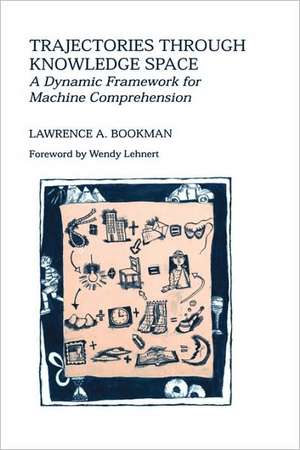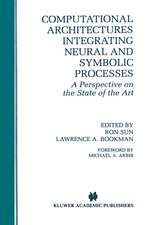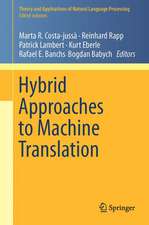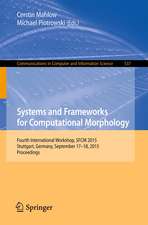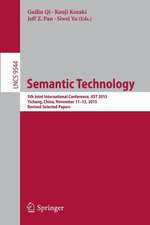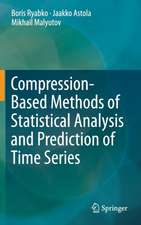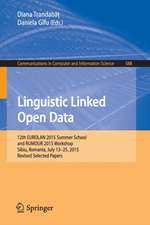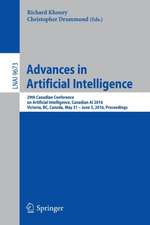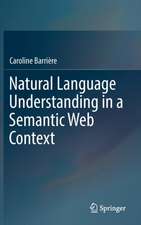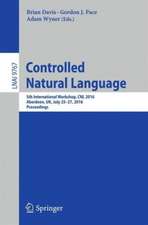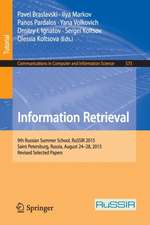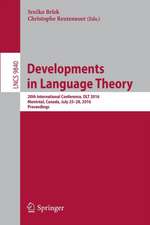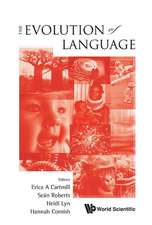Trajectories through Knowledge Space: A Dynamic Framework for Machine Comprehension: The Springer International Series in Engineering and Computer Science, cartea 286
Autor Lawrence A. Bookmanen Limba Engleză Hardback – 30 sep 1994
| Toate formatele și edițiile | Preț | Express |
|---|---|---|
| Paperback (1) | 1271.60 lei 43-57 zile | |
| Springer Us – 11 oct 2012 | 1271.60 lei 43-57 zile | |
| Hardback (1) | 1277.89 lei 43-57 zile | |
| Springer Us – 30 sep 1994 | 1277.89 lei 43-57 zile |
Din seria The Springer International Series in Engineering and Computer Science
- 24%
 Preț: 1041.97 lei
Preț: 1041.97 lei - 20%
 Preț: 643.50 lei
Preț: 643.50 lei - 18%
 Preț: 1225.62 lei
Preț: 1225.62 lei - 18%
 Preț: 965.02 lei
Preț: 965.02 lei - 20%
 Preț: 646.12 lei
Preț: 646.12 lei - 18%
 Preț: 948.79 lei
Preț: 948.79 lei - 20%
 Preț: 646.62 lei
Preț: 646.62 lei - 15%
 Preț: 637.46 lei
Preț: 637.46 lei - 20%
 Preț: 643.83 lei
Preț: 643.83 lei - 18%
 Preț: 949.23 lei
Preț: 949.23 lei - 20%
 Preț: 644.48 lei
Preț: 644.48 lei - 20%
 Preț: 994.92 lei
Preț: 994.92 lei - 20%
 Preț: 645.97 lei
Preț: 645.97 lei - 18%
 Preț: 946.87 lei
Preț: 946.87 lei - 20%
 Preț: 995.57 lei
Preț: 995.57 lei - 18%
 Preț: 956.99 lei
Preț: 956.99 lei - 20%
 Preț: 644.98 lei
Preț: 644.98 lei - 15%
 Preț: 649.54 lei
Preț: 649.54 lei - 18%
 Preț: 950.21 lei
Preț: 950.21 lei - 18%
 Preț: 1221.38 lei
Preț: 1221.38 lei - 18%
 Preț: 957.62 lei
Preț: 957.62 lei - 15%
 Preț: 643.99 lei
Preț: 643.99 lei - 18%
 Preț: 948.47 lei
Preț: 948.47 lei - 18%
 Preț: 947.35 lei
Preț: 947.35 lei - 20%
 Preț: 1284.65 lei
Preț: 1284.65 lei - 20%
 Preț: 1633.95 lei
Preț: 1633.95 lei - 20%
 Preț: 1285.78 lei
Preț: 1285.78 lei
Preț: 1277.89 lei
Preț vechi: 1597.37 lei
-20% Nou
Puncte Express: 1917
Preț estimativ în valută:
244.53€ • 255.95$ • 203.52£
244.53€ • 255.95$ • 203.52£
Carte tipărită la comandă
Livrare economică 31 martie-14 aprilie
Preluare comenzi: 021 569.72.76
Specificații
ISBN-13: 9780792394877
ISBN-10: 0792394879
Pagini: 271
Ilustrații: XXI, 271 p.
Dimensiuni: 155 x 235 x 18 mm
Greutate: 0.59 kg
Ediția:1994
Editura: Springer Us
Colecția Springer
Seria The Springer International Series in Engineering and Computer Science
Locul publicării:New York, NY, United States
ISBN-10: 0792394879
Pagini: 271
Ilustrații: XXI, 271 p.
Dimensiuni: 155 x 235 x 18 mm
Greutate: 0.59 kg
Ediția:1994
Editura: Springer Us
Colecția Springer
Seria The Springer International Series in Engineering and Computer Science
Locul publicării:New York, NY, United States
Public țintă
ResearchCuprins
1 Introduction.- 1.1 Motivation.- 1.2 A View of Text Comprehension.- 1.3 Overview of the LeMICON System.- 1.4 Implementation.- 1.5 Points of Interest.- 1.6 The Impact of this Work on Four Related Fields.- 1.7 Development of the Two-Tier Model.- 1.8 A Guide to the Reader.- 2 An Overview of Connectionist and Probabilistic Approaches to Language Processing.- 2.1 A Computational Linguistics Perspective.- 2.2 A Connectionist Perspective.- 2.3 A Comparison of Connectionist and Probabilistic NLP Methods.- 2.4 Bridging the Gap — Integrating Connectionist and Computational Linguistic Approaches.- 3 Memory Architecture.- 3.1 The Relational Tier.- 3.2 The Associational or ASF Tier.- 3.3 Connecting the Two Tiers.- 3.4 Working Memory.- 3.5 How New Knowledge Is Integrated.- 4 The Basic Computation.- 4.1 A Functional Description of the Algorithm.- 4.2 Representing the Input.- 4.3 Computational Details and Program Output at each Step.- 4.4 General Discussion of the Algorithm.- 4.5 How LeMICON Handles Binding.- 4.6 The Links to Psychology and Neurophysiology Revisited.- 4.7 Some Comparisons to Other Text Understanding Systems.- 5 Analysis of the Interpretation at the Relational and ASF Level.- 5.1 Introduction.- 5.2 Analyzing the Interpretation at the Relational Level.- 5.3 Analyzing the Interpretation at the ASF Level.- 5.4 Analyzing Time-Dependent Interactions at the ASF Level.- 5.5 Comparing Interpretations — A Quantitative Analysis.- 5.6 An Ablation Study.- 6 Reasoning from the Relational Level of the Representation.- 6.1 Introduction.- 6.2 Identifying the Conceptual Roots.- 6.3 Explaining the Connections Between Events.- 6.4 Determining Important Concepts in the Interpretation Graph.- 6.5 Conceptual Roots and their Role in Summarization.- 7 Experiments in Acquiring Knowledgefrom On-line Corpora.- 7.1 Introduction.- 7.2 The Automatic Acquisition of Knowledge from On-line Sources.- 7.3 The Automatic Construction of the Relational Tier.- 7.4 The Automatic Construction of the Associational Tier.- 7.5 How Semantic Memory Evolves in Response to New Input.- 7.6 Changing the Link Weights.- 7.7 Implementation Details.- 8 An Analysis of the Acquired Knowledge.- 8.1 An Alternative View of the Underlying Knowledge Representation.- 8.2 Discussion of Soundness of Approach.- 8.3 An Evaluation of LeMICON’s Representation.- 8.4 Previous Text Systems Revisited.- 8.5 The Knowledge Acquisition Continuum.- 9 Conclusions.- 9.1 Some Consequences of the Two-Tier Model of Memory.- 9.2 Associational Representations.- 9.3 The Universality of ASFs.- 9.4 Scalability.- 9.5 Automatic Acquisition of Knowledge.- 9.6 Building Large-Scale Knowledge Bases.- 9.7 A Link to Corpus Linguistics.- 9.8 The Interplay between Computation and Representation.- 9.9 Limitations.- 10 Future Directions.- 10.1 Expanding The Knowledge Base.- 10.2 Finding Deeper Semantic Relationships via Corpus Analysis.- 10.3 Handling Contradictory Input.- 10.4 Learning New Relationships.- 10.5 A Basic Level Semantic Encoding.- 10.6 Child Versus Adult Comprehension.- References.- Author Index.
